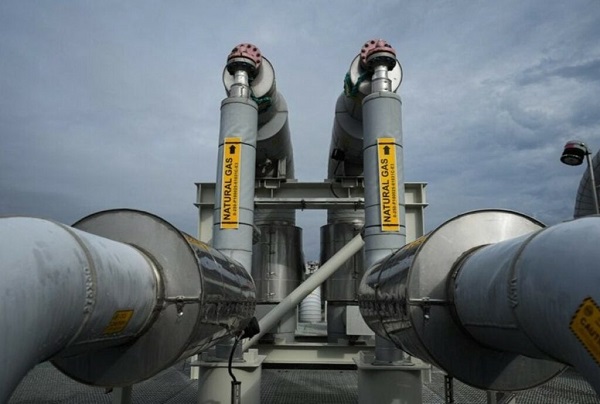Business
It’s Time for Canadians to Challenge the American Domination of the LNG Space

From EnergyNow.Ca
By Susan McArthur
Canada is now among the top 10 countries with natural gas reserves. It’s time to take advantage of that
Canadians are starting to understand the Americans ate our breakfast, lunch and dinner when it comes to selling liquefied natural gas (LNG) on the global market while simultaneously undermining our national security.
They are finally waking up to the importance of the urgent request by oil and gas CEOs to all federal party leaders calling for the removal of legislation and regulation impeding and capping the development of our resources.
The LNG story in the United States is one of unprecedented growth, according to a recent Atlantic Council report by Daniel Yergin and Madeline Jowdy. Ten years ago, the U.S. did not export a single tonne of LNG. Today, U.S. exports account for 25 per cent of the global market and have contributed US$400 billion to its gross domestic product (GDP) over the past decade.
The U.S. is now the world’s largest LNG supplier, edging out Qatar and Australia, and according to Yergin and Jowdy, its export market is on track to contribute US$1.3 trillion to U.S. GDP by 2040 and create an average of 500,000 jobs annually.
Last week, Alberta announced a sixfold increase in its proven natural gas reserves to 130 trillion cubic feet (tcf). The new figures push Canada into the top 10 countries with natural gas reserves.
Unfortunately, notwithstanding this vast resource, Canada didn’t even make it to the LNG party and the Americans have been laughing all the way to the bank at Canada’s expense. Our decade-long anti-pipeline and natural resource agenda has cost us dearly and Donald Trump’s trade tariffs are a stake to the heart.
As the world grapples with global warming, natural gas is the perfect transition fuel. It generates half the CO2 emissions of coal, provides needed grid backup for intermittent renewable wind and solar power, and it is relatively easy to commission.
Canada has extensive natural gas reserves, but these reserves are less valuable if we can’t get them to offshore markets where countries will pay a premium for energy generation. Canadian gas is abundant, but, given our smaller market, typically trades at a discount to U.S. gas and a massive discount to European and Asian markets.
The capital-intensive nature of LNG facilities requires long-term supply contracts. Generally, 20-year supply contracts with creditworthy counterparties are required to secure the financing required to build gas infrastructure and liquefaction plants.
For example, as part of a larger strategic deal, Houston-based LNG company NextDecade Corp. signed a 20-year offtake agreement to supply 5.4 million tonnes per annum (mtpa) to French multinational TotalEnergies SE.
As the market grows and matures, the spot market is gaining share, but term contracts continue to represent most of the market. This is a problem for Canada as it tries to break into the market, as much of current and future demand is already committed.
More than half the current LNG market demand, or 225 mtpa, is under contract until 2040, according to Shell PLC’s LNG outlook report for 2024. A further 100 mtpa is contracted to 2045. Shell recently revised its LNG market growth forecast upward to 700 mtpa by 2040 and it estimates the LNG supply currently in operation or under construction already accounts for about 525 mtpa, or almost 75 per cent of the estimated market in 2040.
Even if Canada secured 100 per cent of the available market share (impossible), this represents a fraction of the 130 trillion cubic feet of reserves in Alberta and an infinitesimal amount of Canada’s natural gas reserve.
If Canada wants to sell its LNG to the global market, it needs to be at the starting line now. Canada has seven LNG export projects in various stages of development. They are all in British Columbia. The capacity of these export plants is 50 mtpa and the capital cost is estimated to be $110 billion.
After significant delays and cost overruns, our first export facility, LNG Canada’s 14 mtpa Phase 1 in Kitimat, is set to ship its first cargo to Asia later this year. Phase 2, representing a further 14 mtpa, is still awaiting a final investment decision. The Cedar LNG, Ksi Lisims LNG and Woodfibre LNG projects are licensed, at various stages of development and represent a further 17 mtpa.
Canada’s LNG exports today are a drop in the bucket compared to both our potential and the 88 mtpa exported by the U.S. in 2024. We have one project completed and, if history repeats itself and Canada doesn’t get its act together, the runway for the remaining licensed projects will be long, painful and costly.
Financing large capital projects requires predictability with respect to timing and cost. This is also a problem for Canada. As the oil and gas CEOs have pointed out, LNG market players have lost trust in Canada as an investible jurisdiction for these projects.
In the face of Trump’s trade war, Canadians have become pipeline evangelists. Wishful thinking and political talking points won’t be enough if we repeat our decade of own goals on this file. We have literally left billions on the table.
Governments should fast-track all licensed projects, limit special interest distractions and provide the required muscle and financial support to get these projects up and running as soon as possible.
From Churchill, Man., to Quebec to the Maritimes to British Columbia, we should be making plans for LNG terminals and the required pipeline infrastructure to get this valuable and clean resource to market. And Canadians should pray we haven’t totally missed the market.
Susan McArthur is a former venture capital investor, investment banker and current corporate director. She has previously served on a chemical logistics and oil service board.
Business
There’s No Bias at CBC News, You Say? Well, OK…

It’s been nearly a year since I last wrote about the CBC. In the intervening months, the Prescott memo on bias at the BBC was released, whose stunning allegations of systemic journalistic malpractice “inspired” multiple senior officials to leave the corporation. Given how the institutional bias driving problems at the BBC is undoubtedly widely shared by CBC employees, I’d be surprised if there weren’t similar flaws embedded inside the stuff we’re being fed here in Canada.
Apparently, besides receiving nearly two billion dollars¹ annually in direct and indirect government funding, CBC also employs around a third of all of Canada’s full time journalists. So taxpayers have a legitimate interest in knowing what we’re getting out of the deal.
Naturally, corporate president Marie-Philippe Bouchard has solemnly denied the existence of any bias in CBC reporting. But I’d be more comfortable seeing some evidence of that with my own eyes. Given that I personally can easily go multiple months without watching any CBC programming or even visiting their website, “my own eyes” will require some creative redefinition.
So this time around I collected the titles and descriptions from nearly 300 stories that were randomly chosen from the CBC Top Stories RSS feed from the first half of 2025. You can view the results for yourself here. I then used AI tools to analyze the data for possible bias (how events are interpreted) and agendas (which events are selected). I also looked for:
- Institutional viewpoint bias
- Public-sector framing
- Cultural-identity prioritization
- Government-source dependency
- Social-progressive emphasis
Here’s what I discovered.
Story Selection Bias
Millions of things happen every day. And many thousands of those might be of interest to Canadians. Naturally, no news publisher has the bandwidth to cover all of them, so deciding which stories to include in anyone’s Top Story feed will involve a lot of filtering. To give us a sense of what filtering standards are used at the CBC, let’s break down coverage by topic.
Of the 300 stories covered by my data, around 30 percent – month after month – focused on Donald Trump and U.S.- Canada relations. Another 12-15 percent related to Gaza and the Israel-Palestine conflict. Domestic politics – including election coverage – took up another 12 percent, Indigenous issues attracted 9 percent, climate and the environment grabbed 8 percent, and gender identity, health-care worker assaults, immigrant suffering, and crime attracted around 4 percent each.
Now here’s a partial list of significant stories from the target time frame (the first half of 2025) that weren’t meaningfully represented in my sample of CBC’s Top Stories:
- Housing affordability crisis barely appears (one of the top voter concerns in actual 2025 polls).
- Immigration levels and labour-market impact.
- Crime-rate increases or policing controversies (unless tied to Indigenous or racialized victims).
- Private-sector investment success stories.
- Any sustained positive coverage of the oil/gas sector (even when prices are high).
- Critical examination of public-sector growth or pension liabilities.
- Chinese interference or CCP influence in Canada (despite ongoing inquiries in real life).
- The rest of the known galaxy (besides Gaza and the U.S.)
Interpretation Bias
There’s an obvious pattern of favoring certain identity narratives. The Indigenous are always framed as victims of historic injustice, Palestinian and Gazan actions are overwhelmingly sympathetic, while anything done by Israelis is “aggression”. Transgender representation in uniformly affirmative while dissent is bigotry.
By contrast, stories critical of immigration policy, sympathetic to Israeli/Jewish perspectives, or skeptical of gender medicine are virtually non-existent in this sample.
That’s not to say that, in the real world, injustice doesn’t exist. It surely does. But a neutral and objective news service should be able to present important stories using a neutral and objective voice. That obviously doesn’t happen at the CBC.
Consider these obvious examples:
- “Trump claims there are only ‘2 genders.’ Historians say that’s never been true” – here’s an overt editorial contradiction in the headline itself.
- “Trump bans transgender female athletes from women’s sports” which is framed as an attack rather than a policy debate.
And your choice of wording counts more than you might realize. Verbs like “slams”, “blasts”, and “warns” are used almost exclusively describing the actions of conservative figures like Trump, Poilievre, or Danielle Smith, while “experts say”, “historians say”, and “doctors say” are repeatedly used to rebut conservative policy.
Similarly, Palestinian casualties are invariably “killed“ by Israeli forces – using the active voice – while Israeli casualties, when mentioned at all, are described using the passive voice.
Institutional Viewpoint Bias
A primary – perhaps the primary job – of a serious journalist is to challenge the government’s narrative. Because if journalists don’t even try to hold public officials to account, then no one else can. Even the valuable work of the Auditor General or the Parliamentary Budget Officer will be wasted, because there will be no one to amplify their claims of wrongdoing. And Canadians will have no way of hearing the bad news.
So it can’t be a good sign when around 62 percent of domestic political stories published by the nation’s public broadcaster either quote government (federal or provincial) sources as the primary voice, or are framed around government announcements, reports, funding promises, or inquiries.
In other words, a majority of what the CBC does involves providing stenography services for their paymasters.
Here are just a few examples:
- “Federal government apologizes for ‘profound harm’ of Dundas Harbour relocations”
- “Jordan’s Principle funding… being extended through 2026: Indigenous Services”
- “Liberal government announces dental care expansion the day before expected election call”
Agencies like the Bank of Canada, Indigenous Services Canada, and Transportation Safety Board are routinely presented as authoritative and neutral. By contrast, opposition or industry critiques are usually presented as secondary (“…but critics say”) or are simply invisible. Overall, private-sector actors like airlines, oil companies, or developers are far more likely to be criticized.
All this is classic institutional bias: the state and its agencies are the default lens through which reality is filtered.
Not unlike the horrors going on at the BBC, much of this bias is likely unconscious. I’m sure that presenting this evidence to CBC editors and managers would evoke little more than blank stares. This stuff flies way below the radar.
But as one of the AI tools I used concluded:
In short, this 2025 CBC RSS sample shows a very strong and consistent left-progressive institutional bias both in story selection (agenda) and in framing (interpretation). The outlet functions less as a neutral public broadcaster and more as an amplifier of government, public-sector, and social-progressive narratives, with particular hostility reserved for Donald Trump, Canadian conservatives, and anything that could be construed as “right-wing misinformation.”
And here’s the bottom line from a second tool:
The data reveals a consistent editorial worldview where legitimate change flows from institutions downward, identity group membership is newsworthy, and systemic intervention is the default solution framework.
You might also enjoy:
Is Updating a Few Thousand Readers Worth a Half Million Taxpayer Dollars? |
||||||
|
||||||
| Plenty has been written about the many difficulties faced by legacy news media operations. You might even recall reading about the troubled CBC and the Liberal government’s ill-fated Online News Act in these very pages. Traditional subscription and broadcast models are drying up, and on-line ad-based revenues are in sharp decline. | ||||||
|
Agriculture
Supply Management Is Making Your Christmas Dinner More Expensive

From the Frontier Centre for Public Policy
By Conrad Eder
The food may be festive, but the price tag isn’t, and supply management is to blame
With Christmas around the corner, Canadians will be heading to the grocery store to pick up the essentials for a tasty Christmas feast. Milk and eggs to make dinner rolls, butter for creamy mashed potatoes, an assortment of cheeses as an appetizer, and, of course, the Christmas turkey.
All delicious. All essential. And all more expensive than they need to be because of a longstanding government policy. It’s called supply management.
Consider what a family might purchase when hosting Christmas dinner. Two cartons of eggs, two cartons of milk, a couple of blocks of cheese, a few sticks of butter, and an eight-kilogram turkey. According to Agriculture and Agri-Food Canada and Statistics Canada, that basket of goods costs a little less than $80.
Using price premiums calculated in a 2015 University of Manitoba study, Canada’s supply management system is responsible for $16.69 to $20.48 of the cost of that Christmas dinner. That’s a 21 to 26 per cent premium Canadian consumers pay on those five staples alone. Planning on making a yogurt dip or serving ice cream with dessert? Those extra costs continue to climb.
Canadians pay these premiums for poultry, dairy and eggs because of how Canada’s supply management system works. Farmers must obtain government-issued production quotas that dictate how much they’re allowed to produce. Prices are set by government bodies rather than in an open market. High tariffs block imports and restrict competition from international producers.
The costs of supply management are significant, amounting to billions of dollars every year, yet they are largely hidden, spread across millions of households’ grocery bills. Meanwhile, the benefits flow to a small number of quota-holding farmers. Their quotas are worth millions of dollars and help ensure profitable returns.
These farmers have every incentive to lobby, organize and defend the current system. Wanting special protection is one thing. Actually being given it is another. It is the responsibility of elected officials to resist such demands. Elected to represent all Canadians, politicians should unapologetically prioritize the public interest over any special interests.
Yet in June 2025, Parliament did the opposite. Rather than solve a problem that costs Canadians billions each year, members of Parliament from every party, Liberal, Conservative, Bloc, NDP and Green, unanimously approved Bill C-202, further entrenching the system that makes grocery bills more expensive at a time when families can least afford it. Bill C-202 prohibits Canada from offering any further market access concessions on supply-managed sectors in future trade negotiations.
This decision is even more disappointing when we consider what other nations have already accomplished. Australia and New Zealand demonstrate that removing supply management is not only possible but beneficial.
Australia operated a dairy quota system for decades before abolishing it in 2000. New Zealand began dismantling its dairy supply management regime in 1984 and completed the process in 2001. Both countries found that competitive markets provided their citizens with the access to goods they needed without the hidden costs. If these countries could eliminate supply management, so can Canada.
As the government scrambles to combat the rising cost of living, one of the simplest and most effective solutions continues to be ignored. Eliminating supply management. Removing the quotas, the price controls and the tariffs would allow market competition to do what it does across every other product category. It delivers choice, quality and affordability.
As Canadians gather for Christmas dinner, the feast may be delicious, but it will once again be more expensive than it needs to be. That is the cost of supply management, and Canadians should no longer have to bear it.
Conrad Eder is a policy analyst at the Frontier Centre for Public Policy.
-

 International2 days ago
International2 days agoOttawa is still dodging the China interference threat
-

 Health1 day ago
Health1 day agoFDA warns ‘breast binder’ manufacturers to stop marketing to gender-confused girls
-

 Business18 hours ago
Business18 hours agoThere’s No Bias at CBC News, You Say? Well, OK…
-

 espionage2 days ago
espionage2 days agoCarney Floor Crossing Raises Counterintelligence Questions aimed at China, Former Senior Mountie Argues
-

 Business1 day ago
Business1 day agoTaxing food is like slapping a surcharge on hunger. It needs to end
-

 Agriculture1 day ago
Agriculture1 day agoSupply Management Is Making Your Christmas Dinner More Expensive
-

 International1 day ago
International1 day ago2025: The Year The Narrative Changed
-

 COVID-192 days ago
COVID-192 days agoJudge denies Canadian gov’t request to take away Freedom Convoy leader’s truck












